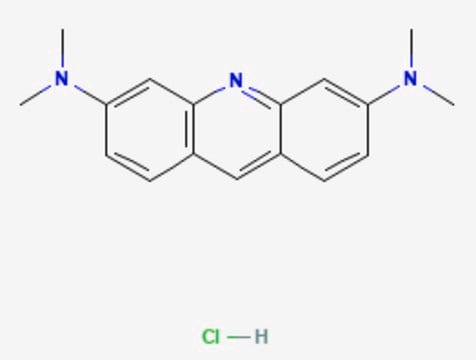318337
Acridine Orange hydrochloride hydrate
≥98% (HPLC)
Synonim(y):
3,6-Bis(dimethylamino)acridine hydrochloride
About This Item
Polecane produkty
Poziom jakości
Próba
≥98% (HPLC)
Postać
powder
kolor
orange
mp
284-287 °C (lit.)
rozpuszczalność
H2O: 0.1%, clear, orange to red
λmaks.
492 nm
ε (współczynnik ekstynkcji)
≥14,000 at 227-233 nm in water at 0.005 g/L
≥35000 at 265-271 nm in water at 0.005 g/L
Zastosowanie
diagnostic assay manufacturing
hematology
histology
temp. przechowywania
room temp
ciąg SMILES
Cl[H].[H]O[H].CN(C)c1ccc2cc3ccc(cc3nc2c1)N(C)C
InChI
1S/C17H19N3.ClH.H2O/c1-19(2)14-7-5-12-9-13-6-8-15(20(3)4)11-17(13)18-16(12)10-14;;/h5-11H,1-4H3;1H;1H2
Klucz InChI
JUAAUEXLEKAEQC-UHFFFAOYSA-N
Szukasz podobnych produktów? Odwiedź Przewodnik dotyczący porównywania produktów
Zastosowanie
- to stain intracellular acidic vesicles.
- to measure lysosomal membrane permeability (LMP).
- or autophagy detection.
Działania biochem./fizjol.
Hasło ostrzegawcze
Warning
Zwroty wskazujące rodzaj zagrożenia
Zwroty wskazujące środki ostrożności
Klasyfikacja zagrożeń
Muta. 2
Kod klasy składowania
11 - Combustible Solids
Klasa zagrożenia wodnego (WGK)
WGK 3
Temperatura zapłonu (°F)
Not applicable
Temperatura zapłonu (°C)
Not applicable
Środki ochrony indywidualnej
Eyeshields, Gloves, type N95 (US)
Choose from one of the most recent versions:
Masz już ten produkt?
Dokumenty związane z niedawno zakupionymi produktami zostały zamieszczone w Bibliotece dokumentów.
Klienci oglądali również te produkty
Nasz zespół naukowców ma doświadczenie we wszystkich obszarach badań, w tym w naukach przyrodniczych, materiałoznawstwie, syntezie chemicznej, chromatografii, analityce i wielu innych dziedzinach.
Skontaktuj się z zespołem ds. pomocy technicznej








